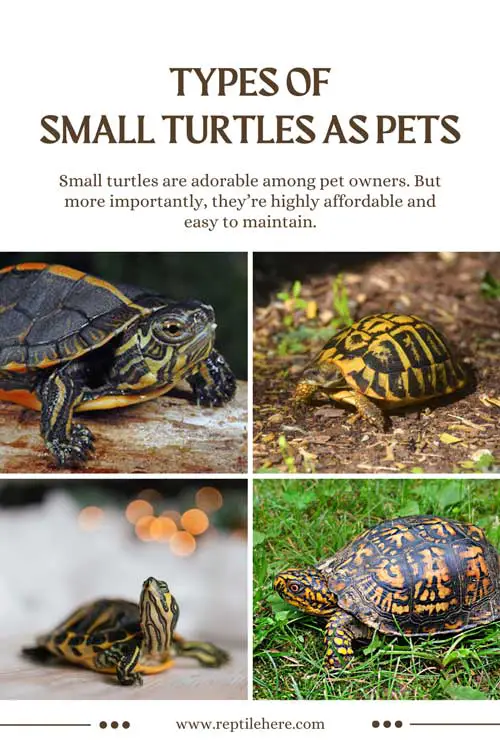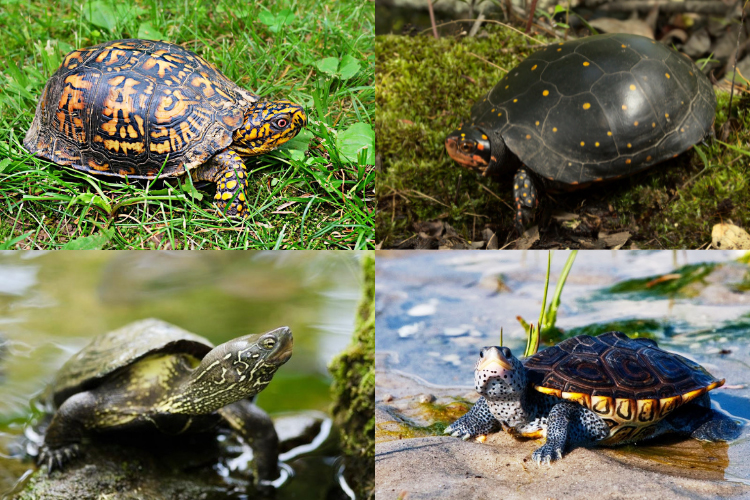Types Of Small Turtles As Pets That Stay Small Forever
Small turtles are adorable among pet owners. But more importantly, they’re highly affordable and easy to maintain. They take up small space, making them ideal for apartments or bedrooms.
This is unlike some species that tend to grow into big sizes in adulthood and becomes more demanding to manage that their owners wish they could stay small forever.
That said, some types of turtle species tend to remain small from a young age to adult age—they stay small forever. And this has earned them a place in the hearts of turtle owners all over.
In this guide, you’ll discover some of the top types of small pet turtles that stay small forever.
1. Common Musk Turtle
Contents
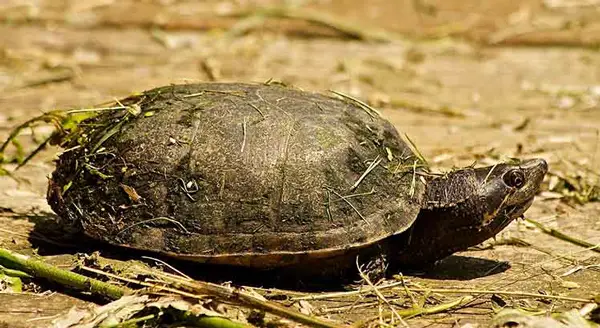
- Size: 2 to 4.5 inches
- Scientific name: Sternotherus odoratus
- Common name: Eastern Musk Turtle, Common Musk Turtle, Musk Turtle, Stinkpot
- Family: Kinosternidae
- Lifespan: 30 to 50 years
- Conservation status: Least Concern
The common musk turtle is one of the pet turtles that stays small forever! An average adult eastern musk turtle is quite small (2 to 4.5 inches long).
In terms of appearance, this turtle has a pretty plain appearance with highly consistent colors. Both the shell and skin usually share the same color and can range from dark brown to black.
It is usually found in slow-moving and sluggish streams as well as still-water bodies. The turtle prefers areas with dark crevices, where it can easily hide. It also prefers lots of plant matter to burrow in and hide.
The turtle shell has one unique feature—a ridge traversing its entire shell length. Besides, it has another distinctive feature: two light-colored stripes on its head.
Common musk turtles are herbivorous and will eat small aquatic or semi-aquatic animals, carrion, and aquatic vegetation. They will also feed on any other vegetation on land.
When it feels threatened, this turtle species emits a foul odor (a musky odor, hence its name). This scent can be detected in water or on land. It can also easily waft through the air to its predators.
2. Razorback Musk Turtle
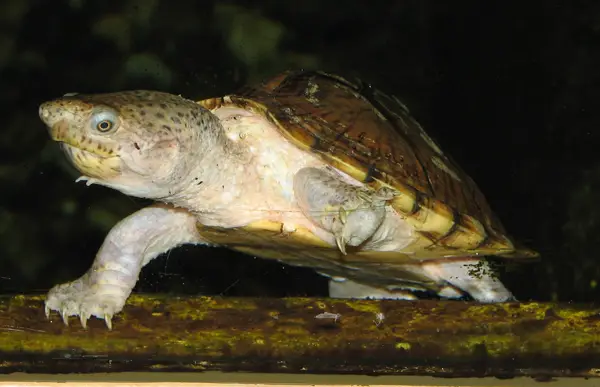
- Size: 5 to 6 inches
- Scientific name: Sternotherus carinatus
- Common name: Musk turtle, stinkpot
- Family: Kinosternidae
- Lifespan: 40 to 50 years
- Conservation status: Least Concern
Just like the common musk turtle, this species is also pretty small and the average adult hits 5-6 inches in length. Their shell color ranges from light grey to olive, brown, and black.
It is identified by the keels on its back. In other words, its carapace is shaped like a tent that comes to a point along its spine and then slopes down on its sides.
Skin color can be olive or dark brown, though the exact color differs from individual to individual.
These turtles usually have long necks and large heads which usually have bright colors and turn gray with dark spots as they age.
This razor-back musk turtle prefers living in water almost entirely and will only leave the waters to bask or when it’s time to lay eggs. The species live in deep waters of oxbow lakes and river swamps. They also prefer living in slow-current large streams.
Diet-wise, the razor-back musk turtle is mainly carnivorous and is fond of fish, mollusks, and snails.
3. Eastern Mud Turtle
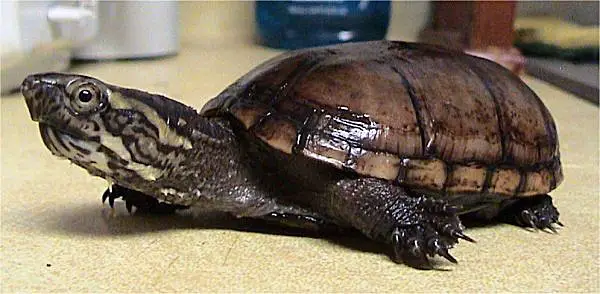
- Size: 3 to 5 inches
- Scientific name: Kinosternon subrubrum
- Common name: Eastern Mud Turtle, Mud Turtle
- Family: Kinosternidae
- Lifespan: 50 years
- Conservation status: Least Concern
The adult Eastern Mud turtle is around 3 to 5 inches long, making it another great choice for a pet that stays small forever.
In the wild, this turtle is commonly found in shallow waters including ditches, marshes, wet meadows, and swamps.
This smaller aquatic turtle species is characterized by a smooth and unmarked shell. It has an incredible plain look, with its upper shell lacking any patterns. The carapace color ranges from dark yellow to black.
The lower side of the shell is also pretty plain, though it usually appears lighter on the upper part. The key distinction of this mud turtle is the stripes on its head which can be white or yellow in color.
One particular feature that sets this turtle apart from others and makes it easily identifiable is the hinges on its lower shell which form a “K” shape when viewed from the sides.
Just as its name suggests, this turtle lives in water bodies with a soft muddy, or sandy bottom. Thus, they can be found in marshes, swamps, and rivers.
Since the eastern mud turtle is omnivorous, it eats meat, fish, snails, insects, and aquatic vegetation as well as plant matter on land.
Unlike other turtles, eastern mud turtles do not hibernate in the cold winter months. Instead, it does the opposite—it becomes dormant in the hot months of summer (this is known as aestivation).
4. Painted Turtle
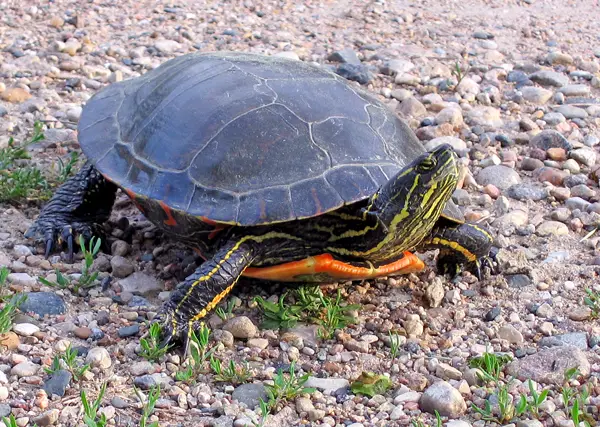
- Size: 4 to 6 inches
- Scientific name: Chrysemys picta
- Common name: Painted Turtle
- Family: Emydidae
- Lifespan: 30 to 50 years
- Conservation status: Least Concern
The painted turtle is another cute pet turtle that stays small forever. An average adult is 4 to inches long. However, the females tend to get bigger (up to 1 foot), so we only recommend keeping the males for pets.
Besides size, the painted turtle is one of the most recognizable turtle species, thanks to its beautiful and unique coloring. The bright reds and yellow-green markings on its shell, head, and limbs are no doubt a beauty to behold!
This painted turtle sub-species has been observed to live near water bodies with minimal movements. Examples include marshes, ponds, slow-moving streams with sandy/muddy bottoms, small lakes, etc.
They also prefer areas with aquatic plants in plenty as they make their primary food source in the wild.
One interesting fact about these turtles is their ability to hold their breath for up to 30 hours when inside temperate water. Moreover, they’re capable of standing dominant in freezing cold waters for up to 4 months.
Unfortunately, it’s not easy to establish the population of these turtles. This is because most people who pet them end up releasing them back into the wild. This contributes to an ever-expanding range plus unstable reproduction rates for these turtles.
5. Bog Turtle

- Size: 3.5 to 5 inches
- Scientific name: Glyptemys muhlenbergii
- Common name: Bog Turtle, Muhlenberg’s turtle
- Family: Emydidae
- Lifespan: up to 40 years
- Conservation status: Critically Endangered
The Bog turtle is the smallest aquatic turtle you’ll find in North America! This cute turtle is 3.5 to 5 inches long and will be the best choice for turtle owners with limited space.
The species is critically endangered and is one of the rarest turtles in many states. Selling or owning a bog turtle in most US states is illegal!
An adult bog turtle’s carapace coloration ranges from black to olive or dark brown and features a central keel ridge.
Some of the scutes making up their upper shell may also bear red or yellow-star markings. And their heads have distinctive orange or yellow patches.
The bog turtle is known to inhabit wetland areas such as marshes or bogs populated with grass cover.
The turtle species are diurnal omnivores and like eating insects, mollusks, and occasional vegetation. They’re most active during warm parts of the day.
6. Spotted Turtle
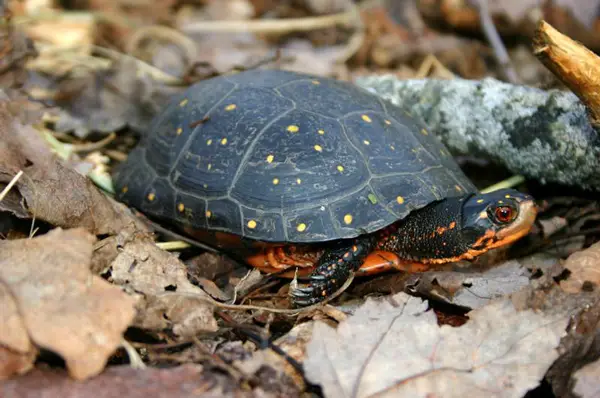
- Size: 4 to 5 inches
- Scientific name: Clemmys guttata
- Common name: Spotted Turtle
- Family: Emydidae
- Lifespan: 25 to 50 years
- Conservation status: Endangered
The female Spotted turtles usually grow larger than their male counterparts. Nonetheless, the turtles have a small size in adulthood ranging from 4 to 7 inches, making them another great choice of pets.
The turtle resides in shallow marshes, swamps, and bogs. They’re semi-aquatic and are comfortable on land just as they are in the waters.
An adult spotted turtle has a smooth upper shell that ranges from olive to dark brown in color, with some light yellow spots. The neck and head feature irregular orange or yellow spots and streaks. Their tails are fairly long.
The turtles are omnivorous and their diet involves crustaceans, mollusks, insects, and plant matter (occasionally). Note that these turtles are aggressive hunters and will actively seek their prey.
Unfortunately, the population of spotted turtles is on the decline due to human interference and habitat loss. Their unique shell patterns make them a favorite species of pet turtle for many people.
For this reason, they’re listed as endangered and protected by many governing bodies across various states.
Above all, spotted turtles are incredibly smart. Studies carried on them using a maze even indicate that they have the same brain capacity as the mouse!
7. Diamondback Terrapins
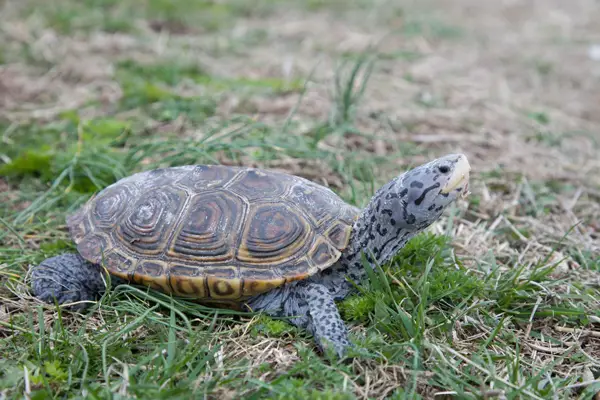
- Size: 4 to 6 inches (males), 5 to 8 inches (females)
- Scientific name: Malaclemys terrapin
- Common name: Diamondback Terrapin
- Family: Emydidae
- Lifespan: 25 to 35 years
- Conservation status: Vulnerable
Female diamondback terrapins are usually bigger than their male counterparts. Males can get up to 6 inches in length while females can get up to 8 inches.
Diamondback terrapin is the only freshwater turtle that can adapt to saltwater as well. Their shells have a raised diamond shape, hence the name diamondback. The term “terrapin” simply means little turtle.
A typical diamondback terrapin has a black-to-brown carapace and yellow lower shell that may sometimes feature dark-colored patterns. The turtle’s skin is usually grey-white with multiple small black spots.
These turtles are highly timid and can easily get stressed when in captivity. They’re pretty docile and can be handled. However, they’re known to bite as a way of defending themselves if they feel threatened.
Diamondback terrapins can be found along the coast in tidal flats, salt marshes, barrier beaches, and brackish streams. They can also stay in full-strength saltwater for longer periods of time.
The terrapins are largely carnivorous and feed on crustaceans, fish, crabs, shrimps, marine snails, marine worms, mollusks, mussels, clams, and barnacles. However, they also tend to occasionally ingest small amounts of plant matter.
8. Reeve’s Turtle
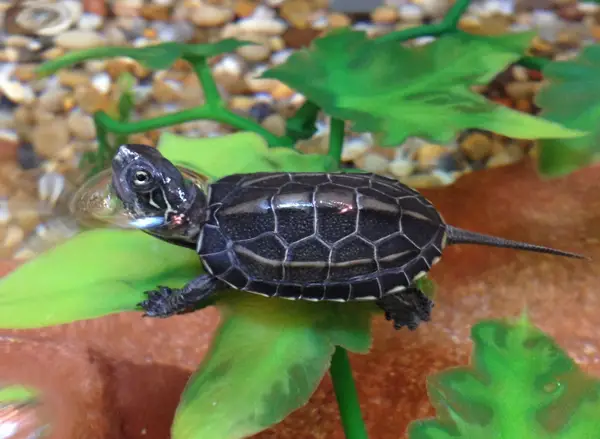
- Size: 6 to 9 inches
- Scientific name: Mauremys reevesii
- Common name: Reeve’s Turtle, Chinese three-keeled pond turtle, Chinese pond turtle
- Family: Geoemydidae
- Lifespan: 10 to 20 years
- Conservation status: Endangered species
The adult size for Reeve’s turtle is 6-9 inches, which is pretty easy to manage for all pet owners.
This turtle is also known as the Chinese pond turtle as it inhabits China and its range extends towards north and south Korea, Japan, and Taiwan. They usually inhabit small streams, lakes, and ponds.
The turtle mostly has a plain look but has a few distinctions that make it easily identifiable from other species of turtles. Its shell features 3 longitudinal keels with colors ranging from olive green to black to tan.
We feature the turtle on this list because it’s quite hardy to keep as a pet and requires a simple diet.
However, keep in mind that this aquatic turtle isn’t a good swimmer, so you should be careful with the water levels in its enclosures. As a general rule, the water depth should be 1½ the turtle shell length.
Remember, this turtle has a lifespan of up to 20 years with proper care, diet, and housing—making it a longtime companion for you.
9. Eastern Box Turtle
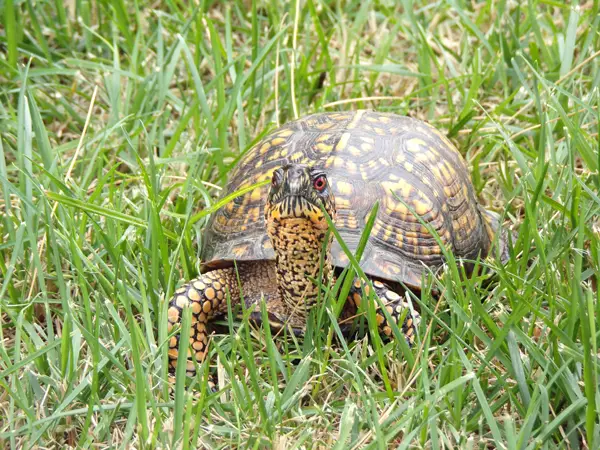
- Size: 4.5 and 7 inches
- Scientific name: Terrapene carolina
- Common name: Eastern Box Turtle, Land turtle, Box Turtle
- Family: Emydidae
- Lifespan: 50 to 100 years
- Conservation status: Vulnerable
The eastern box turtle also tends to stay small forever. The average size of an adult is about 4.5 to 7 inches and weighs just 2lbs.
The box turtle has a high, domed shell shape with a ridge running from head to toe. The shell of this turtle has varying colors of olive, brown, and tan.
They usually inhabit dense thickets and woodland areas. They prefer these areas due to abundant access to sunlight and food sources nearby.
The variation in markings on the shells of these turtles is so variable that you can’t easily recognize one by looking at the shell alone.
These eastern box turtles are omnivorous and feed on a variety of foods including insects, meat, fruits, vegetables, and various types of vegetation.
Note that eastern box turtles are taken from the wild for pet trade, leading to a decline in their population. For this reason, many states have illegalized capturing and selling of this species.
And those in captivity end up dying due to poor conditions or being abandoned or released back into the wild because they’re too demanding to maintain.
Conclusion
That’s it for our list of the top small pet turtles that stay small forever. The different types of turtles we have featured on this list range from musk turtles to mud turtles, spotted turtles, diamondback terrapins, bog turtles, and even eastern box turtles.
While some of the species featured on this list have their females growing into slightly larger sizes than the males, they’re still within the “Small” size range in their adulthood and a favorite for pet owners of all experience levels.
Remember, small turtles are eye-pleasing and easy to care for. They also don’t require a lot of space and are suitable for apartments and bedrooms. Which of these small pet turtles would you consider for a pet?
